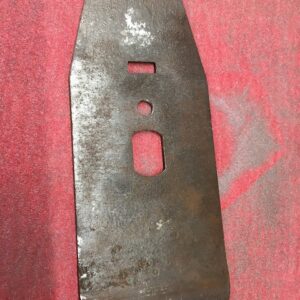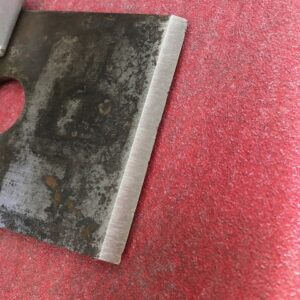I have a limited amount of experience with hand planes, but I own a few. I recently bought an old #7 Stanley/Bailey. The body and frog are in good condition. The blade and cap iron, not so much. I’ve worked on the blade for awhile and am coming to the conclusion that I will probably need to replace it. Wondering if I should just buy a new cap iron as well. This plane will be used in a working shop, not restored to collectible condition.
I’ve attached images. Thanks for your input!



















Replies
I'd replace both. Either a Veritas PM-V11, or Hock.
I've restored a Stanley no. 3 and 4 - they both got Hock A2 blades/breakers. Oddly, I just got a Stanley type 17 no. 7 last week and the same Hock set up ordered for this as well. Excellent performance, reasonable cost, and a time saver - would not even think twice about it. I would replace them as well.
Thanks for your replies! I've just heard about the PM-V11 blades but don't know anything about them.
Also, are all of the Hock blades square on the top? I'm sure it doesn't matter with regard to their performance. Where do the Hock blades come from?
https://www.hocktools.com/faq/why-are-some-hock-blades-made-in-france.html
Is there any chance that the Coneheads might be involved? (They're from France, or so they said.)
If you want to save some bucks, try the ruler trick on the back of the blade. Pitting is the enemy to sharp. You just need it pit free right at the cutting edge. The ruler trick shines here. Your bevel is good. The cap is okay to function as is. Up grading to a new blade and cap will be an improvement but I have found I get by fine without the upgrade if I can sharpen the original. Regular replacement blades work well too and are less expensive. Let us know what you do.
I got a replacement Iron and Chipbreaker for my Sweetheart vintage #7 from Ron Hock. I put the originals in a drawer in case I ever sell it.
I replaced my iron on my Stanley #7 with a Hock 01 blade and chip breaker. Worked great. I talked to Ron Hock on the phone about A2 vs O1....he uses O1's in his planes....feels it is sharper and any loss of sharpness over that of the A2 is minimal. I have a Veritas #4 with an A2 in it and can't get it as sharp as my O1s....am sticking with the latter,.
I replaced most of my Bailey blades with PMV11, and one Hock A2. I also have A2 in two Lie Nielsen planes. A2 holds an edge well, but it’s harder to sharpen and like others have mentioned I don’t feel it gets quite as sharp as PMV11, or the original blades. Looking at the pitting on your blade I’d get a Hock O1 or Veritas PMV11 replacement and new chip breaker. The new chip breakers with the thicker blades do seem to work smoother. I can’t say if the thicker blade alone is all you need.
The Veritas blades are dead flat right out of the box, which is really a time saver, and the Hock was very close as well.
Well, I ordered a Veritas PM-V11 with a chip breaker. I came to the conclusion that there was too much pitting on the back side of the blade. Might have worked OK, but...
I really appreciate all of the responses you have provided!
One additional question: I have a friend who owns a machine shop. He would be able to plane the sole just a whisker for me. Then I'd bring it back to the shop and polish it up. I can't imagine that this would create a problem, but I'm sure some of you must have experience or knowledge about this. Thanks again!
Do you mean a surface grinder? This will make the (sole) bottom flat. You can do the same thing with sandpaper on a flat surface. Necessary? I don't know. Place on a flat surface like a jointer bed or a glass plate and check with feeler gauges.
I’ve never had a plane machined. I would use it before you try that and see if it’s needed. If you do machine or sand the bottom be aware it should have the blade installed, tensioned, and retracted.
Why is it necessary to have the blade installed, tensioned, and retracted?
I'm only considering it because it's so long. I got into the habit of sanding/flattening and polishing machined surfaces on parts when I was restoring old motorcycles.
A plane can flex and change shape slightly under tension. If you flatten it without the blade installed it may pull out of flat when you set it up for use. You want to flatten under the same stresses as it when it is in use.
A properly set up machinist can remove metal much more precisely and more quickly then a glass plate and sandpaper. If your mate is a good machinist (since he owns his own shop I expect he is) go for it. Ditto the comments about having the blade in but retracted etc. The trade school I went to had a machinist program and they were required and able to be incredibly precise compared to the wood manufacturing/cabinet students who were more precise then the carpentry students and so on. Keep that friend on your Christmas card list, friends like that are nice to have.
This forum post is now archived. Commenting has been disabled